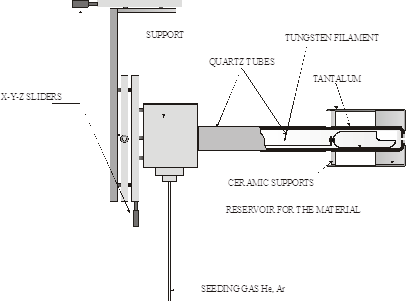
The SuMBD is based on the seeding of heavier species inside a lighter carrier gas. A supersonic expansion is realized through a nozzle (typically with a diameter between 50 to 150 microns). In this way, the supersonic expansion of the lighter carrier gas determines the properties in terms of kinetic energy and cooling of the heavier species. The source used for this purpose is drawn in the figure below.

In our lab in Trento, we use this technique to study the effect of the kinetic energy and momentum on the molecular assembling for thin film formation [1]. We explore the possibility to use the kinetic energy of the seeded molecules to activate surface chemical reactions, e.g., for the growth of thin films (SiC) [2] and the possibility to activate surface functionalization processes [3].
Several films are growth with this technique such as different organic molecules (acenes, oligothiophenes, phthalocyanines etc) and metal such as (Ca, Zn, Ag)
[1] S. Gottardi, T. Toccoli, Y. Wu, S. Iannotta, P. Rudolf
Growth dynamics in supersonic molecular beam deposition of pentacene sub-monolayers on SiO2
Chemical Communications 50, 7694-7697 (2014)
[2] R. Verucchi, L. Aversa, M. V. Nardi, S. Taioli, S. a Beccara, D. Alfè, L. Nasi, F. Rossi, G. Salviati, and S. Iannotta
Epitaxy of Nanocrystalline Silicon Carbide on Si(111) at Room Temperature
Journal of the American Chemical Society 2012, 134, 42, 17400-17403;
[3] Pantano MF, Tatti R, Aversa L, Verucchi R and Pugno NM
Doubling the Mechanical Properties of Spider Silk by C60 Supersonic Molecular Beam Epitaxy
Frontiers in Materials 7, 197 (2020)








